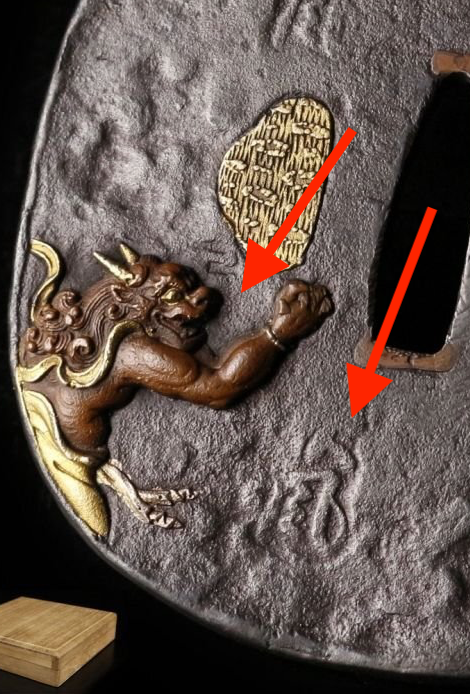
John C
Members-
Posts
2,592 -
Joined
-
Last visited
-
Days Won
17
Content Type
Profiles
Forums
Events
Store
Downloads
Gallery
Everything posted by John C
-
Update: 2 days left and up to 306 dollars. Can't wait until someone eventually posts it here. John C.
-
Chris: Just as an aside, the term nyudo is used on swords to describe a monk or one who has joined the priesthood. John C.
-
Here is a google translation for the regs on the left side: Translation 1. The long sword, trumpet, and cavalry equipment (excluding the sabretache) are to be carried by the cavalry. 2. Officers at government offices, schools (excluding the self-funded car school), headquarters, material depots (excluding air corps material depots and maintenance units), military police, and corporals are to carry the Type 32 Model B sword (non-commissioned officers and soldiers of the headquarters non-commissioned officer committee and air corps maintenance units are excluded from this table). 3. Chief mechanics, non-commissioned officers and soldiers of all units, and heavy artillery special duty personnel are to carry the Type 30 bayonet. 4. Non-commissioned officers and soldiers of the balloon corps are to carry the Type 30 and Type 14 weapons. 5. Students of the Army Signal School are to carry the Type 30 bayonet. 6. Students of the Army Aviation School are to carry the Type 30 bayonet. 7. Students of the Army Cadet School are to carry the branch insignia of their assigned branch. (Including acting paymasters, acting medical officers, acting veterinary officers, and acting engineering officers) Acting officers are to carry the officer's sword. 8. Students of the Army Youth School are to carry the Type 30 bayonet. 9. Students of the Army Engineering School are to carry the Type 30 bayonet. 10. Students of the Military Music School are to carry the Type 30 bayonet. 11. The Type 38 cavalry rifle is to be carried in addition to this table by the Chief of Military Police in Kyoto, Osaka, Kobe, and the high-ranking military police chiefs. John C.
-
Update: up to 201 dollars now. John C.
-
Bruce: Just for reference, mine is in similar condition and set-up as the one above. And, happens to be one number later "66". John C.
-
Another one of the 40127 fakes. This one is already up to 151 dollars with 5 days left. Described accurately, however at least two people must think it is real. https://shopgoodwill.com/item/247839701 John C.
-
The shape of the kissaki seems odd to me. Is that a feature of Bizen? John C.
-
So would these have been hand carved from a lump of clay then fired? At the time, I would think these would have been done for the masses. But now they are more expensive than bone or metal? I'm glad you posted it. I would have walked right past it in a shop. John C.
-
Steve: Google app has it as "medical bag". John C. p.s. if you take a screenshot of the original picture and drop it into the googe search bar, it will come up with a translate button on the bottom right. Click on that and it will translate the kanji fairly well (except hand written or unreadable stuff).
-
Increasing Gold Membership numbers?
John C replied to Brian's topic in General Nihonto Related Discussion
I'm sure there is a good reason for not using advertising as a revenue source. But I have seen several sites where membership (gold in this case) is ad free, while visiting is not. Is that an option? John C. -
Andre: Difficult to say from one picture, however it appears at first glance that the fittings are the type found on reproduction swords. We would need more pictures of the blade and tang to have a better assessment. Regards, John C.
-
Western numbers were common, however stamped or painted not chiseled. Maybe Bruce @Bruce Pennington has seen it. John C.
-
Steve: As a general rule, always assume gimei if not papered. But also, with a big name in particular, if papers raise the value substantially why didn't the previous owners get it papered? Or, did they try and it didn't pass? Without a thorough kantei of the blade itself, it's just guesswork. And just my personal thing, I get suspicious quickly of flowery descriptions. He's trying to sell the sword a little too hard. John C. p.s. From marketing 101 - people like to buy; they don't like to be sold.
-
World War II Sword, Maybe?
John C replied to garbage finds's topic in General Nihonto Related Discussion
Jeff: There is a technique for cleaning textiles (in this case silk or possibly cotton) that are fragile. It's one that some restorers use: Put some water in a container with a little mild dish soap - something that is non-detergent but cuts grease. Whisk it or mix it vigorously until you get a lot of bubbles. Using a clean rag, scoop up some of the bubbles - bubbles only, not the water - and gently dab the rag on the sticky spots. The key is to not get too wet and not to rub. John C. -
William: This appears to be a date. Is there anything on the other side of the tang? John C.
-
LIG ART GALLERY- CAUTION
John C replied to cluckdaddy76's topic in Auctions and Online Sales or Sellers
Oh crap. Do you think he gives refunds? Just kidding... What caught my eye first, though, was how the low point looks old and weathered but the high point looks pristine. John C. -
World War II Sword, Maybe?
John C replied to garbage finds's topic in General Nihonto Related Discussion
Hello: This is indeed a legit sword in navy kaigunto fittings. Not sure of the smith name (kane something) so you'll have to wait for a translation. The stamp just above the hole in the tang is the Seki inspection stamp, indicating it is not traditionally made. But still, a nice piece of ww2 history. John C. -
The single hanger suggests type 98. In that condition (see the reproduction brass seppa?) I would not go anywhere near 3000 AUD for a non-traditional blade. You can get a star-stamped gendaito for that kind of money. John C.
-
Moriyama-san wrote it correctly in kanji so probably just a mis-type. John C.
-
Can't believe I'm stumped on a simple date
John C replied to John C's topic in Translation Assistance
Ah. So it could be gannen, just stylized quite a bit. Thanks for the confirmation. John C. -
Hi folks: I'm trying to figure out the highlighted character, which I assume is "year one" somehow, however I can't seem to find it in any of my reference charts. The closest I can come up to is: 元 (gan): "original" or "first". The smith died in Heisei one (1989), so it can't be year two or other. Any help is appreceiated. John C.
-
Thank you, John. John C.
-
Update: Tom - I found the auction and got a picture of the marks on the ricasso from him. Thanks again. For those interested: We now have 41 Meiji 25 (1892) serial numbers; 9 different inspector stamps. Still working on deciphering the the stamps to get a list of potential inspector names. John C.
-
As Sam indicated, yes. Indeed, you almost have to if posting a picture from the auction to "cite your source" according to Fair Use Doctrine (you can use it for research or education, like in this case, just not commercially). John C.







